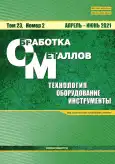Probabilistic model of surface layer removal when grinding brittle non-metallic materials
- Authors: Bratan S.M.1, Roshchupkin S.I.1, Kharchenko A.O.1, Chasovitina A.S.1
-
Affiliations:
- Issue: Vol 23, No 2 (2021)
- Pages: 6-16
- Section: TECHNOLOGY
- URL: https://bakhtiniada.ru/1994-6309/article/view/301936
- DOI: https://doi.org/10.17212/1994-6309-2021-23.2-6-16
- ID: 301936
Cite item
Abstract
About the authors
S. M. Bratan
Email: serg.bratan@gmail.com
D.Sc. (Engineering), Professor, Sevastopol State University, 33 Universitetskaya str., Sevastopol, 299053, Russian Federation, serg.bratan@gmail.com
S. I. Roshchupkin
Email: st.roshchupkin@yandex.ru
Ph.D. (Engineering), Associate Professor, Sevastopol State University, 33 Universitetskaya str., Sevastopol, 299053, Russian Federation, st.roshchupkin@yandex.ru
A. O. Kharchenko
Email: khao@list.ru
Ph.D. (Engineering), Professor, Sevastopol State University, 33 Universitetskaya str., Sevastopol, 299053, Russian Federation, khao@list.ru
A. S. Chasovitina
Email: nastya.chasovitina@mail.ru
Sevastopol State University, 33 Universitetskaya str., Sevastopol, 299053, Russian Federation, nastya.chasovitina@mail.ru
References
- Malkin S., Guo C. Grinding technology: theory and applications of machining with abrasives. – New York: Industrial Press, 2008. – 372 р. – ISBN 978-0-8311-3247-7.
- Hou Z.B., Komanduri R. On the mechanics of the grinding process. Pt. 1. Stochastic nature of the grinding process // International Journal of Machine Tools and Manufacture. – 2003. – Vol. 43. – P. 1579–1593. – doi: 10.1016/S0890-6955(03)00186-X.
- Lajmert P., Sikora V., Ostrowski D. A dynamic model of cylindrical plunge grinding process for chatter phenomena investigation // MATEC Web of Conferences. – 2018. – Vol. 148. – P. 09004. – doi: 10.1051/matecconf/20181480900.
- A time-domain surface grinding model for dynamic simulation / M. Leonesio, P. Parenti, A. Cassinari, G. Bianchi, M. Monn // Procedia CIRP. – 2012. – Vol. 4. – P. 166–171. – doi: 10.1016/j.procir.2012.10.030.
- Sidorov D., Sazonov S., Revenko D. Building a dynamic model of the internal cylindrical grinding process // Procedia Engineering. – 2016. – Vol. 150. – P. 400–405. – doi: 10.1016/j.proeng.2016.06.739.
- Zhang N., Kirpitchenko I., Liu D.K. Dynamic model of the grinding process // Journal of Sound and Vibration. – 2005. – Vol. 280. – P. 425–432. – doi: 10.1016/j.jsv.2003.12.006.
- Estimation of dynamic grinding wheel wear in plunge grinding / M. Ahrens, J. Damm, M. Dagen, B. Denkena, T. Ortmaier // Procedia CIRP. – 2017. – Vol. 58. – P. 422–427. – doi: 10.1016/j.procir.2017.03.247.
- Garitaonandia I., Fernandes M.H., Albizuri J. Dynamic model of a centerless grinding machine based on an updated FE model // International Journal of Machine Tools and Manufacture. – 2008. – Vol. 48. – P. 832–840. – doi: 10.1016/j.ijmachtools.2007.12.001.
- Tawakolia T., Reinecke H., Vesali A. An experimental study on the dynamic behavior of grinding wheels in high efficiency deep grinding // Procedia CIRP. – 2012. – Vol. 1. – P. 382–387. – doi: 10.1016/j.procir.2012.04.068.
- Dynamic modeling and simulation of a nonlinear, non-autonomous grinding system considering spatially periodic waviness on workpiece surface / J. Jung, P. Kim, H. Kim, J. Seok // Simulation Modelling Practice and Theory. – 2015. – Vol. 57. – P. 88–99. – doi: 10.1016/j.simpat.2015.06.005.
- Yu H., Wang J., Lu Y. Modeling and analysis of dynamic cutting points density of the grinding wheel with an abrasive phyllotactic pattern // The International Journal of Advanced Manufacturing Technology. – 2016. – Vol. 86. – P. 1933–1943. – doi: 10.1007/s00170-015-8262-0.
- Guo J. Surface roughness prediction by combining static and dynamic features in cylindrical traverse grinding // The International Journal of Advanced Manufacturing Technology. – 2014. – Vol. 75. – P. 1245–1252. – doi: 10.1007/s00170-014-6189-5.
- A new approach for dynamic modelling of energy consumption in the grinding process using recurrent neural networks / A. Arriandiaga, E. Portillo, J.A. Sanchez, I. Cabanes, I. Pombo // Neural Computing and Applications. – 2016. – Vol. 27. – P. 1577–1592. – doi: 10.1007/s00521-015-1957-1.
- Soler Ya.I., Le N.V., Si M.D. Influence of rigidity of the hardened parts on forming the shape accuracy during flat grinding // MATEC Web of Conferences. – 2017. – Vol. 129. – P. 01076. – doi: 10.1051/matecconf/201712901076.
- Солер Я.И., Хоанг Н.А. Влияние глубины резания на высотные шероховатости инструментов из стали У10А при плоском шлифовании кругами из кубического нитрида бора // Авиамашиностроение и транспорт Сибири: сборник материалов IX Всероссийской научно-практической конференции / Иркутский национальный исследовательский технический университет. – Иркутск, 2017. – С. 250–254.
- Calculation of surface roughness parameters for external cylindrical grinding / Yu. Novoselov, S. Bratan, V. Bogutsky, Yu. Gutsalenko // Fiabiltate si Durabilitate = Fiability and Durability. – 2013. – Suppl. 1. – P. 5–15.
- Новоселов Ю.К. Динамика формообразования поверхностей при абразивной обработке. – Севастополь: СевНТУ, 2012. – 304 с. – ISBN 978-617-612-051-3.
- Лобанов Д.В., Янюшкин А.С., Архипов П.В. Напряженно-деформированное состояние твердосплавных режущих элементов при алмазном затачивании // Вектор науки Тольяттинского государственного университета. – 2015. – № 3-1 (33-1). – С. 85–91. – doi: 10.18323/2073-5073-2015-3-85-91.
- Kassen G., Werner G. Kinematische Kenngrößen des Schleifvorganges // Industrie-Anzeiger. – 1969. – N 87. – P. 91–95.
- Identification of removal parameters at combined grinding of conductive ceramic materials / S. Bratan, S. Roshchupkin, A. Kolesov, B. Bogutsky // MATEC Web of Conferences. – 2017. – Vol. 129. – P. 01079. doi: 10.1051/matecconf/201712901079.
- Гусев В.В., Моисеев Д.А. Износ алмазного шлифовального круга при обработке керамики // Прогрессивные технологии и системы машиностроения. – 2019. – № 4 (67). – С. 25–29.
- Novoselov Yu., Bratan S., Bogutsky B. Analysis of relation between grinding wheel wear and abrasive grains wear // Procedia Engineering. – 2016. – Vol. 150. – P. 809–814. – doi: 10.1016/j.proeng.2016.07.116.
Supplementary files






